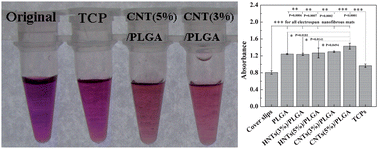One major method used to evaluate the biocompatibility of porous tissue engineering scaffolding materials is MTT (3-(4,5-Dimethylthiazol-2-yl)-2,5-diphenyltetrazolium bromide) assay. The MTT cell viability assay is based on the absorbance of the dissolved MTT formazan crystals formed in living cells, which is proportional to the number of viable cells. Due to the strong dye sorption capability of porous scaffolding materials, we propose that the cell viability determined from the MTT assay is likely to give a false negative result. In this study, we aim to explore the effect of the adsorption of MTT formazan on the accuracy of the viability assay of cells cultured onto porous electrospun poly(lactic-co-glycolic acid) (PLGA) nanofibers, HNTs (halloysite nanotubes)/PLGA, and CNTs (multiwalled carbon nanotubes)/PLGA composite nanofibrous mats. The morphology of electrospun nanofibers and L929 mouse fibroblasts cultured onto the nanofibrous scaffolds were observed using scanning electron microscopy. The viability of cells proliferated for 3 days was evaluated through the MTT assay. In the meantime, the adsorption of MTT formazan onto the same electrospun nanofibers was evaluated and the standard concentration–absorbance curve was obtained in order to quantify the contribution of the adsorbed MTT formazan during the MTT cell viability assay. We show that the PLGA, and the HNTs- or CNTs-doped PLGA nanofibers display appreciable MTT formazan dye sorption, corresponding to 35.6–50.2% deviation from the real cell viability assay data. The better dye sorption capability of the nanofibers leads to further deviation from the real cell viability. Our study gives a general insight into accurate MTT cytotoxicity assessment of various porous tissue engineering scaffolding materials, and may be applicable to other colorimetric assays for analyzing the biological properties of porous scaffolding materials.

You have access to this article
 Please wait while we load your content...
Something went wrong. Try again?
Please wait while we load your content...
Something went wrong. Try again?


 Please wait while we load your content...
Please wait while we load your content...